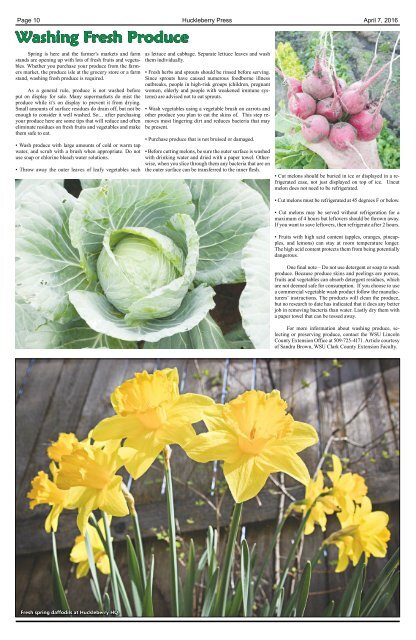Huckleberry Press 040716
You also want an ePaper? Increase the reach of your titles
YUMPU automatically turns print PDFs into web optimized ePapers that Google loves.
Page 10 <strong>Huckleberry</strong> <strong>Press</strong> April 7, 2016<br />
Washing Fresh Produce<br />
Spring is here and the farmer’s markets and farm<br />
stands are opening up with lots of fresh fruits and vegetables.<br />
Whether you purchase your produce from the farmers<br />
market, the produce isle at the grocery store or a farm<br />
stand, washing fresh produce is required.<br />
As a general rule, produce is not washed before<br />
put on display for sale. Many supermarkets do mist the<br />
produce while it’s on display to prevent it from drying.<br />
Small amounts of surface residues do drain off, but not be<br />
enough to consider it well washed. So… after purchasing<br />
your produce here are some tips that will reduce and often<br />
eliminate residues on fresh fruits and vegetables and make<br />
them safe to eat.<br />
• Wash produce with large amounts of cold or warm tap<br />
water, and scrub with a brush when appropriate. Do not<br />
use soap or chlorine bleach water solutions.<br />
• Throw away the outer leaves of leafy vegetables such<br />
as lettuce and cabbage. Separate lettuce leaves and wash<br />
them individually.<br />
• Fresh herbs and sprouts should be rinsed before serving.<br />
Since sprouts have caused numerous foodborne illness<br />
outbreaks, people in high-risk groups (children, pregnant<br />
women, elderly and people with weakened immune systems)<br />
are advised not to eat sprouts.<br />
• Wash vegetables using a vegetable brush on carrots and<br />
other produce you plan to eat the skins of. This step removes<br />
most lingering dirt and reduces bacteria that may<br />
be present.<br />
• Purchase produce that is not bruised or damaged.<br />
• Before cutting melons, be sure the outer surface is washed<br />
with drinking water and dried with a paper towel. Otherwise,<br />
when you slice through them any bacteria that are on<br />
the outer surface can be transferred to the inner flesh.<br />
• Cut melons should be buried in ice or displayed in a refrigerated<br />
case, not just displayed on top of ice. Uncut<br />
melon does not need to be refrigerated.<br />
• Cut melons must be refrigerated at 45 degrees F or below.<br />
• Cut melons may be served without refrigeration for a<br />
maximum of 4 hours but leftovers should be thrown away.<br />
If you want to save leftovers, then refrigerate after 2 hours.<br />
• Fruits with high acid content (apples, oranges, pineapples,<br />
and lemons) can stay at room temperature longer.<br />
The high acid content protects them from being potentially<br />
dangerous.<br />
One final note – Do not use detergent or soap to wash<br />
produce. Because produce skins and peelings are porous,<br />
fruits and vegetables can absorb detergent residues, which<br />
are not deemed safe for consumption. If you choose to use<br />
a commercial vegetable wash product follow the manufacturers’<br />
instructions. The products will clean the produce,<br />
but no research to date has indicated that it does any better<br />
job in removing bacteria than water. Lastly dry them with<br />
a paper towel that can be tossed away.<br />
For more information about washing produce, selecting<br />
or preserving produce, contact the WSU Lincoln<br />
County Extension Office at 509-725-4171. Article courtesy<br />
of Sandra Brown, WSU Clark County Extension Faculty.<br />
Fresh spring daffodils at <strong>Huckleberry</strong> HQ.

















